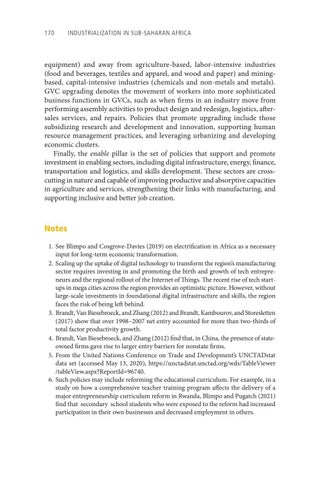170 Industrialization in Sub-Saharan Africa
equipment) and away from agriculture-based, labor-intensive industries (food and beverages, textiles and apparel, and wood and paper) and miningbased, capital-intensive industries (chemicals and non-metals and metals). GVC upgrading denotes the movement of workers into more sophisticated business functions in GVCs, such as when firms in an industry move from performing assembly activities to product design and redesign, logistics, aftersales services, and repairs. Policies that promote upgrading include those subsidizing research and development and innovation, supporting human resource management practices, and leveraging urbanizing and developing economic clusters. Finally, the enable pillar is the set of policies that support and promote investment in enabling sectors, including digital infrastructure, energy, finance, transportation and logistics, and skills development. These sectors are crosscutting in nature and capable of improving productive and absorptive capacities in agriculture and services, strengthening their links with manufacturing, and supporting inclusive and better job creation.
Notes 1. See Blimpo and Cosgrove-Davies (2019) on electrification in Africa as a necessary input for long-term economic transformation. 2. Scaling up the uptake of digital technology to transform the region’s manufacturing sector requires investing in and promoting the birth and growth of tech entrepreneurs and the regional rollout of the Internet of Things. The recent rise of tech startups in mega cities across the region provides an optimistic picture. However, without large-scale investments in foundational digital infrastructure and skills, the region faces the risk of being left behind. 3. Brandt, Van Biesebroeck, and Zhang (2012) and Brandt, Kambourov, and Storesletten (2017) show that over 1998–2007 net entry accounted for more than two-thirds of total factor productivity growth. 4. Brandt, Van Biesebroeck, and Zhang (2012) find that, in China, the presence of stateowned firms gave rise to larger entry barriers for nonstate firms. 5. From the United Nations Conference on Trade and Development’s UNCTADstat data set (accessed May 13, 2020), https://unctadstat.unctad.org/wds/TableViewer /tableView.aspx?ReportId=96740. 6. Such policies may include reforming the educational curriculum. For example, in a study on how a comprehensive teacher training program affects the delivery of a major entrepreneurship curriculum reform in Rwanda, Blimpo and Pugatch (2021) find that secondary school students who were exposed to the reform had increased participation in their own businesses and decreased employment in others.

